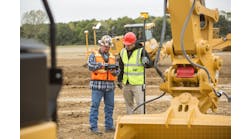JCB: More Than Dancing Diggers
As they always do at the major international construction shows such as ConExpo and Bauma, JCB sent out its “Dancing Diggers” to perform. A sort of Cirque du Soleil for backhoes, the Diggers prance around in a choreographed routine, showing construction equipment's surprising dexterity — by the machines themselves as well as the female violinists who entertained the crowd with classical riffs set to a rock beat.
But the United Kingdom-based manufacturer had a lot more on its mind and a lot more of a story to tell attendees at the Bauma Trade Fair in Munich, Germany, in April. The U.K.-based manufacturer set some aggressive goals for itself in recent years and is doing very well at meeting them.
JCB CEO John Patterson told a Bauma press conference that the company's strategic vision has been threefold.
“The first was to move JCB from being a strong European player to being a global company recognizing the American market, India and China,” Patterson said. “Second, to grow the company's business by expanding our product range to satisfy a much wider customer base and gain strength through our dealer network. And thirdly, the past five years, to achieve a worldwide market share of 10 percent.”
Once regarded by many as too provincial to be a worldwide player, JCB has expanded its global manufacturing capability to 17 facilities, including India, China, Germany, the United Kingdom and the United States. JCB opened a new factory in India in August 2004, and has since doubled production, sending units outside of India as well as selling them to the exploding Indian market.
“In 2006 we built our third Indian plant, producing hydraulic excavators, field loading shovels and compaction equipment,” Patterson said. In October 2006, JCB started production of backhoes and mini-excavators to serve the Chinese market from its Shanghai plant.
JCB opened five new factories since 2004, investing €150 million (about U.S. $200 million by current currency conversion rates), including a parts center in Paris in 2004, enabling it to send parts anywhere in Europe within 12 hours.
JCB now manufactures 279 different machines, so it has certainly made strides in growing its equipment range. In the past three years, JCB has developed a new line of 48 mini-excavators ranging in capacity from 800 kilos to 8 tons, It has launched a new line of compact loaders to the United States market, and a compact loader introduced to the French and German markets has already captured 12 percent of the German market, Patterson said. It developed a new generation of 57 models of hydraulic excavators, and a range of dump trucks from 14 to 22 tones.
In the past, JCB was not particularly known as a compaction equipment player, but last year grew its compaction sales 67 percent, in large part as a result of its acquisition of Vibromaxx in September 2005. It has also developed a new product range of compact tractors for the lawn care industry. The company has also become a major engine manufacturer, having made more than 50,000 dieselmax engines since starting production in November 2004.
In reaching its third strategic goal, JCB claims a 10.4-percent market share, up from about 7 percent in 2001 and trailing closely behind Komatsu's 10.5 percent, with Caterpillar far ahead at 17.5 percent. “Our sales in 2003 were 30,200 machines,” said Patterson. “This increased in 2004 to 37,200, up to 45,000 in 2005 and 55,700 machines in 2006.”
Although the No. 3 market position has been disputed by other manufacturers with different definitions of market share, there is no denying JCB's strong growth, reflected in its sales volume, growing from €1.37 billion in 2003 to €1.67 billion in 2004, €2 million in 2005, to €2.55 billion in 2006.
JCB claims to have re-gained its previous status as No. 1 in sales of backhoe loaders with a 31.4-percent market share. JCB's telescopic handler sales jumped 14 percent in 2006 and the company claims the No. 1 spot in the world telehandler market. JCB also entered the generator market in 2006, introducing a range of generators from 17 to 3,000 kVas.
The company, founded by the Bamford family and still owned by it, has aggressive plans for the future as well. Patterson says more than half the company's sales growth in 2006 came from new product introductions. JCB introduced 36 new products at the Bauma show, and has aggressive expansion plans in numerous markets.
While acknowledging that the strong international construction market fueled its growth spurt, JCB's chief operating officer Mathew Taylor notes that his company's growth has outpaced the overall market. With an international construction market jump of 14 percent, JCB's volume in 2006 increased 23 percent. Its biggest single market growth was in India, where it claims an 80-percent share of the backhoe loader segment. In Russia, where construction growth zoomed 70 percent, JCB jumped 145 percent, and its sales volume broke 1,000 machines. “We saw significant growth in pretty much every market around the world,” Taylor says.
JCB unveiled at Bauma two new telescopic handlers; 15 new tracked and wheeled excavators; eight Series II Robot skid-steer loaders and compact tracked loaders; six new tandem vibratory rollers; two new Midi CX backhoe loaders; two new compact articulated wheeled loading shovels and a new mini-excavator.
New Holland Construction Sees Worldwide Growth
Confidence was strong at New Holland's stand at Bauma. President and CEO Franco Fenoglio exuded confidence in the company's new products, recent performance, and prospects for expanded market share. He says the company's commitment to customer attention is “part of our DNA at all levels.”
Take a ride around the world with Fenoglio and his managers. The markets of East Europe and the Commonwealth of Independent States increased by 45 percent in 2006, and New Holland more than doubled the market growth. In Africa and the Middle East the market grew by 25 percent and New Holland more than doubled that number. It grew more than three times the 70-percent market growth of Russia. In Saudi Arabia, New Holland's penetration was more than four times the rate of market expansion.
“These are very impressive figures, but they are not a miracle,” says Fenoglio. “During 2006, we launched more than 10 new products and we organized our team, creating dedicated marketing and dealer development teams and we organized the dealer network. We invested energy to find best-in-class and competitive partners for a total network of 40 dealers and 60 outlets for the area. We appointed six new ones in East Europe and CIS and nine new ones in Africa and the Middle East. In South Africa, we signed an agreement with Imperial, a diversified group with an income of over $7 billion per year, which allowed us to be present in 12 southeastern African countries.”
New Holland grew 34 percent in the Asia Pacific region, working together with partner Kobelco in many areas. Significant advances in the development of New Holland's dealer network in countries as diverse as South Korea, Indonesia and Australia have spurred strong sales figures.
New Holland did some strong marketing in recent years, from its sponsorship of the Torino, Italy, winter Olympics in 2006 to James Bond driving its 90B wheel loader in the movie “Casino Royale” to its sponsorship of Torino's popular Juventus soccer club for the 2007-08 season.
New Holland Construction has marketed well, but marketing will only go so far without the products to back it up. “The market requires product excellence, and for our brands that means a complete range of products with 12 product families, 80 models and more than 600 configurations,” says Fenoglio.
Fenoglio adds that being part of the resurgent Fiat Group enables New Holland to leverage its costs in areas such as research and development and beyond.
“We are able to leverage support from a common purchasing organization with Iveco and from the Fiat Powertrain technology sector,” says Fenoglio, who is bullish about Fiat's engines performance, environment sensitivity as well as fuel consumption.
While New Holland sees a slowdown in the current North American market, it sees great strength on the industrial construction side of the U.S. business as demand for warehouses and office buildings continues. The company has upgraded its skid-steer loader line, has made great strides in improving its dealer network, has increased production and is offering a more sophisticated slate of financing packages.
Among the new offerings at New Holland's stand was its new compact track loaders, the C175 and C185. The units have a turbocharged New Holland engine rated at 43kW/57hp - 55kW/74 gross hp, and feature a standard two-speed transmission for travel speeds up to 7.4 kilometers (4.6 miles) per hour. The New Holland staff is particularly enthusiastic about the units' improved visibility, with no rear frame towers to block the operators' view.
Briggs & Stratton Launches European Applications Center
Briggs & Stratton Commercial Power announced its recently opened European Engine Applications Centre in Viernheim, Germany. The facility, which will function similarly to Briggs & Stratton's applications center at its Milwaukee headquarters, offers customers services such as engine fit-up, prototyping, and performance and durability testing.
“Collaboration and testing with the Briggs & Stratton EAC helps manufacturers build more productive, efficient equipment by helping them optimize powerplant selection, testing and fit-up earlier in the development process,” says Robert Spletter, sales director, Commercial Power Europe. “EAC services also help streamline the product development process for Briggs & Stratton customers. Instead of designing a piece of equipment first, then choosing a powerplant, product managers can now work in partnership with the Briggs & Stratton EAC to precisely match equipment design requirements with the best powerplant options up-front, at the beginning of the product development process.”
Briggs & Stratton also introduced at Bauma a new series of 5.5- to 9-hp Vanguard single-cylinder engines for the commercial market. The new engines feature an industrial dual element air cleaner system as standard, which allows the engine to be used in demanding environments with double protection from airborne debris. The optimized surface area of the air filter elements ensures that the smaller airborne particles do not enter the engine when working in harsh and dusty environments.
“Airborne debris entering the engine is one of the major causes of premature engine wear,” says Paul Bramhall, product category manager for Briggs & Stratton Commercial Power.
Godwin Pumps Expands U.K. Manufacturing Facility
At Bauma, Godwin Pumps announced a major makeover at its Gloucestershire, England, factory, including a 15,300-square-foot expansion. Godwin has been manufacturing pumps at its Gloucestershire facility since the end of the 19th century.
Most of the space has been used to enlarge the factory area. The company added eight new fitting assembly bays; a new service area and a new electrical department; and a new fully acoustic test facility that enables workers to test flow rates up to 2,800 cubic meters per hour (10,000 gallons per minute), pressures up to 370 psi and powers up to 600 hp.
The remaining 3,300 square feet was designated for offices, with 65 percent of the office area for design and engineering, project engineers and the service management and quality assurance departments.
Godwin Pumps displayed its full range of Dri-Prime pumps at Bauma. It showed its CD series for lower pressure applications — designed for construction dewatering and sewer by-passes — and its JL series for high-lift applications, designed for higher pressure applications such as mine and quarry dewatering and pumping through nozzles or long pipelines.
The HL series offered three new models — the HL110M, HL130M and HL160M. The Dri-Prime pumps can be equipped with diesel or electric drive, manual or automatic controls, high-volume or high-lift pumping capabilities and various construction materials including cast iron, hardened cast steel or stainless steel.
Terex Reaches High School
Now that Terex has reached $7.6 billion in revenue — compared to less than half a billion dollars annually 10 years ago — CEO Ron DeFeo says the company has finally reached high school.
“Terex is a very young company,” says DeFeo. “I used to say that we were a middle-school company, I think we are finally in our first year of secondary education with aspirations to go to the university and maybe have an advanced degree. But we still are very young.”
What DeFeo means is that Terex has a long way to go on the journey with huge growth opportunities ahead. But the growth opportunities to come won't come by acquisition.
“If you examine our business carefully, since 2002 we have made only a few small acquisitions and our business has grown from a little south of $4 billion to $7.6 billion and to the $8.2 to $8.5 billion we expect in 2007.”
Terex has always been a company of aggressive growth and today is no different. After introducing 26 new models in its construction group alone in 2006, it is continuing to offer new products from each of its five product divisions, and had more than 80 products on display at Bauma.
DeFeo said the company's goals for 2010 are 12 × 12 in 10. “That's to be $12 billion in revenue, with a 12-percent operating margin in 2010,” he said. “What must we accomplish? To achieve $12 billion in revenue by 2010, we need to grow the company 12 percent each year. We've grown 28 percent per year [on average] for 11 years.”
Does that mean DeFeo is lowering expectations to reach $12 billion by 2010? Not at all, he says. “But as you get bigger, it's hard to grow a lot faster. Twelve percent is still quite aggressive.
“I don't think you'll find another company with that level of growth. We believe we are operating at about a 10-percent operating margin today, so we need to add about two points of margin improvement. We have significant initiatives with our supply chain to do that. Today Terex buys more steel than a small car company, yet we buy it from 1,000 different suppliers. Think about the potential as we merge our supply and purchasing capabilities together.”
After making a number of major acquisitions in the late 1990s and early 2000s, Terex found itself with the need to improve internal organization and become a unified company. The Westport, Conn.-based manufacturer is confident that the company's internal improvement will facilitate margin improvement.
Another area for growth is international expansion. Terex, with a diverse product range, has many opportunities to expand particular product areas on different continents where it hasn't been as strong in the past.
“We've got an experienced leadership team, both from leaders that have grown up with the company as well as leaders that we have brought into the company,” DeFeo adds. “And if there is any one issue we have, it's the need to continue to develop our talent and have that talent be global in its thinking, to have us view Asia as a domestic market, just like we view Waverly, Iowa, as a domestic market. And if we do that and do that well, with lean initiatives, great things are still possible for us.”





